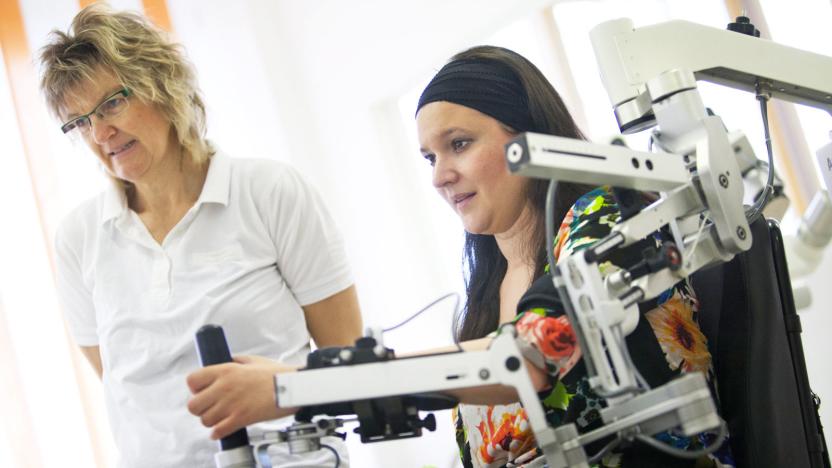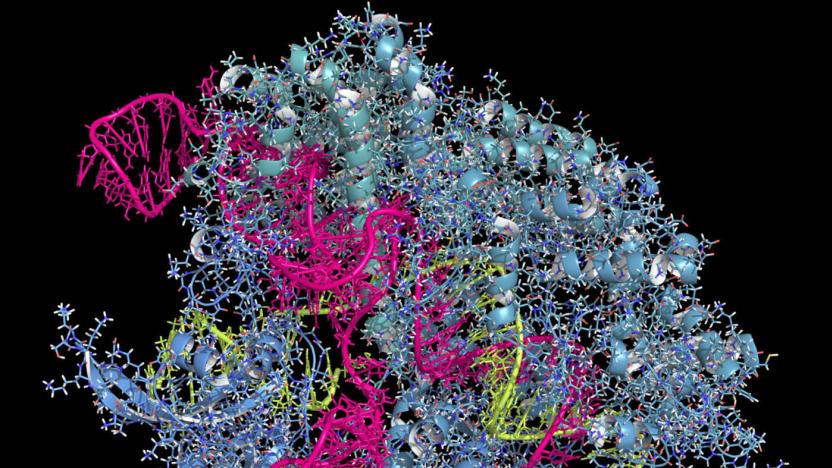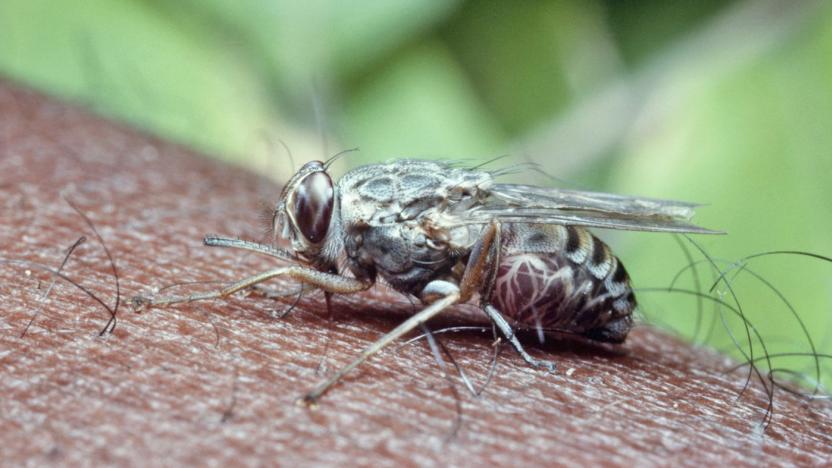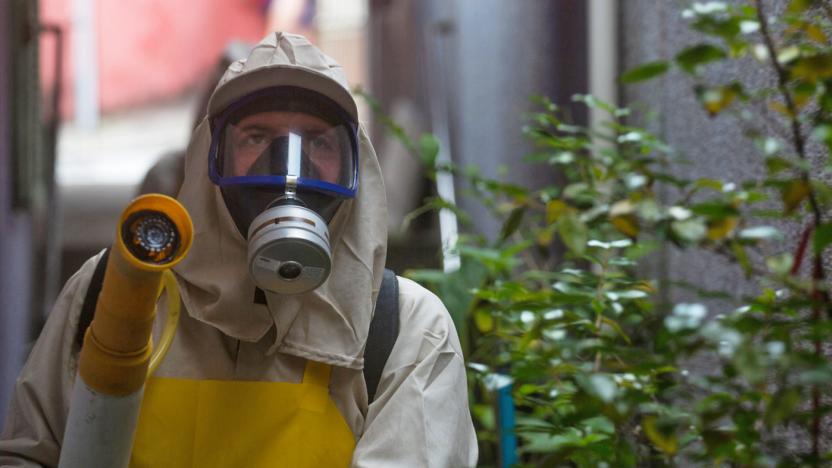disease
Latest

MIT: More collaboration is needed to fight disease
As anyone who follows science knows, a lot of the fields have blended together. Medical research is dependent on robotics and other technology, while computer engineers are building neural networks that mimic our brains. To get everyone working together, leading MIT scientists, including President Emerita Susan Hockfield and Nobel Prize winning geneticist Philip Sharphave, have drafted a paper called "Convergence: The Future of Health." They believe the federal government, academia and industry must grasp the importance of overlapping research and fund it appropriately.

Gene editing discovery might treat many more diseases
In theory, gene editing could eliminate genetic diseases by correcting the flaws in your DNA. However, there's one big obstacle: the current CRISPR technique has trouble modifying individual DNA letters. As most genetic conditions revolve around mutations of those single letters, that leaves most conditions untreatable. However, Harvard researchers might have just made a breakthrough that turns gene editing into a true disease-ending weapon.

Drones deliver sterile insects to tackle disease in Ethiopia
To combat disease-ridden tsetse flies in Africa, the International Atomic Energy Agency (IAEA) is enlisting heavy-duty drones. An autonomous system has been developed by Embention, which can fly for up two hours at a cruise speed of 20 meters per second. Under each wing is a stack of temperature controlled pods, each containing a swarm of sterile male insects. These little creatures have been pummelled with gamma radiation, courtesy of the IAEA, while they were bred in captivity. Once they're in the wild, they mate ferociously with the native population, producing no offspring and consequentially lowering the tsetse fly population.

Sneezing is even more disgusting with high-speed cameras
New, super-gross research out of MIT is shedding new insights into what happens when we sneeze. Researchers from the university used high-speed photography to record 100 healthy volunteers right at the moment they sneezed. Turns out, the sticky fluid flies out of our mouths, not as a spray, but as a sheet. Ew. Then it pops, like a balloon, and the snotty filaments remaining then in turn break up into the fine mist we're familiar with. Double ew.

US medical panel recommends 3-person embyronic testing
The US National Academy of Medicine recommended Wednesday that the Federal Drug Administration should approve clinical trials for so-called "3-parent embryos." It's a controversial procedure that would transfer mitochondria from a healthy, secondary human egg donor into a fertilized diseased embryo.

Zika virus declared an international health emergency
If it wasn't already patently clear that the Zika virus poses a serious threat, it is now. The World Health Organization has declared that Zika is a health emergency "of international concern," and that there needs to be "coordinated" response to both track and limit outbreaks. Effectively, it's a call to action -- countries and organizations are under pressure to devote research and funding toward fighting the mosquito-borne disease.

President Obama wants US to 'reignite its spirit of innovation'
President Obama gave his final State of the Union address on Tuesday. In it, he discussed how far the country has come over the last year and where he sees it going in the future. But beyond the expected talk of a rebuilt, stronger economy, soaring high school graduation rates and new civil liberties, he laid out a bold plan to, as he puts it, make "technology work for us, and not against us."

Scientists show that gene editing can 'turn off' human diseases
Gene editing has already been used to fight diseases, but there's now hope that it might eliminate the diseases altogether. Researchers have shown that it's possible to eliminate facial muscular dystrophy using a newer editing technique, CRISPR (Clusters of Regularly Interspaced Short Palindromic Repeats) to replace the offending gene and 'turn off' the condition. The approach sends a mix of protein and RNA to bind to a gene and give it an overhaul.

Digital pens help spot early signs of brain conditions
Doctors frequently check for early signs of brain conditions like Alzheimer's and Parkinson's by looking at irregularities in your drawings, but it's an imperfect art based largely on the doctor's opinion. All too often, the only concrete signs show up by the time you've already been ravaged by the disease. MIT researchers might have a more effective way to catch these conditions early on, though. By using custom tracking software to monitor the output from a digital pen, they can more accurately predict the onset of brain conditions based not only on what you draw, but how you draw. Healthy people spend a bit more time thinking than scribbling; those with memory issues (such as Alzheimer's sufferers) spend a lot more time in thought, while Parkinson's patients tend to struggle with the drawing process.

Gene-modded mosquitoes will fight Dengue Fever in Brazil
The Brazilian city of Piracicaba has a potent new weapon in the ongoing fight against Dengue Fever, which infects more than a million people annually: genetically modified mosquito lotharios Created by Oxitec of Abingdon, UK and bred locally within Brazil, these GM mosquitoes (all of which are male) are designed to crash the local population before they can spread the tropical disease. More than six million have been released throughout Piracicaba since April. When a GM male mates with a wild female, his sapper genetics cause the resulting larvae to die before they can reach adulthood. What's more, the larvae also carry a genetic mutation that causes them to glow red under UV light, giving researchers an easy way to identify them on sight. "It gives an instant readout of how successfully you're driving down the native population," Hadyn Parry, chief executive of Oxitec, told New Scientist.

The UK will decode the genes of 100,000 people to help fight cancer
The UK is about to launch one of the more ambitious attempts at using genetic research to fight cancer and other nasty diseases. The National Health Service's England branch plans to collect and sequence the genomes of 100,000 people in hopes of understanding both how DNA affects these sicknesses (such as gene-specific causes or symptoms) and what doctors can do to test and treat patients. The strategy will see the NHS run 11 specialized Genomic Medicine Centres across England, with more due in the future. So long as everything goes smoothly, the first recruits will sign up in February.

23andMe's £125 DNA testing service launches in the UK
While more and more technology companies are shifting their focus to include health tracking, none go quite as in-depth as 23andMe. The self-branded "personal genetics company" made its name in the US and Canada for mail-order DNA test kits that provide customers with an overview of their genetic ancestry and provide a risk assessments for certain diseases based on genetic data. That was until its very public spat with the Food and Drug Administration (FDA), which told 23andMe to stop offering disease analysis until it received the medical device classification it needed. The ban is still in place, but 23andMe has continued to offer (with approval) its ancestry-related reports and "uninterpreted raw genetic data" to customers.

Experimental app can detect jaundice in newborns with just a snapshot
Want to make sure your newborn baby's jaundice-free? There's an app for that! A team of researchers from the University of Washington have developed an app that can diagnose jaundice among infants just by taking their pictures. Since the condition's typically diagnosed by the excessive yellowing of one's skin, it's not too odd to develop a tool that can detect it with just a snapshot, just like that app that can spot skin cancer through a smartphone. You simply place a color calibration card (which helps the software determine lighting and flash conditions, as well as account for the baby's skintone) on the baby's tummy, take a picture and then upload it to the cloud for analysis. The algorithm quickly does its job, and you get the results and the baby's bilirubin levels almost instantly.

First UK Google Glass trial gives Parkinson's sufferers more independence
Before Glass becomes a publicly available product, Google's quietly embarked on a campaign to get its iconic eyewear into the hands of those who can use it to tackle complex issues. After it gifted five pairs to researchers at Newcastle University, Google's allowed its wearable to undergo its first UK medical trial, where it's being used to support people suffering from Parkinson's disease. Researchers want to help patients live more independently, and they're already seeing results.

Crowdfunded 'My Carnival' is a video game designed to help children with cystic fibrosis
AccessAble Games has announced a new campaign to raise funds for a free video game designed to help children with cystic fibrosis learn how to perform their breathing exercises correctly. Cystic fibrosis is a genetic disease that requires daily physiotherapy training, and while experts say there are some tools out there to teach affected children already, they're not as helpful and entertaining as they could be. Enter My Carnival, which will use a standard PC mic to track a child's breathing in and out, and can be adjusted depending on the child's ability. Once the breathing is tracked, My Carnival then translates that into playing games at an busy carnival, having the player do things like fill a balloon with a water stream. You can contribute to the project right now. AccessAble's "tipping point" budget of $29,000 would cover just four minigames, but the full budget of $40,000, if raised, would provide for eight minigames total. Currently, the team has only raised just over $1,000 with 23 days left in the effort.

Another reason to buy gold: nanoparticles help to kill brain tumors
Stanford scientists have used lab-made gold nanoparticles to highlight malignant tissue in the brain, making it easier for surgeons to cut out tumors while leaving healthy bits in tact. Measuring just five millionths of an inch in diameter, these tiny glistening orbs are injected into the patient and then left to bleed out through leaky blood vessels in parts of the brain that have been damaged by the disease. They then get stuck in the bad tissue itself, marking it out for the scalpel when viewed with the right type of imaging. It's not totally new -- we've actually seen gold nanotech deployed against the Big C in stem cells before, but better to be useful than avant-garde. [Brain image via Shutterstock]

New Last of Us art pieces hint at a world-ending disease
You might have already guessed that Sony's PS3 exclusive The Last of Us was probably about an apocalyptic virus of some kind, just by watching that video released last weekend. And these two new shots that have appeared on the official site don't do much to prove you wrong: One shot shows a forest, with the view pointed up into the sun, and the second, above, pictures a ruined newspaper stand talking about the President addressing a broken nation as "millions more are feared dead or infected," and quarantines breaking in New Mexico while martial law is declared in England. In short, the world is packed nicely into a handbasket, with some sort of infectious disease filling out the customs-required shipping forms to a final destination of Hell. We've seen the world end lots of times before, but maybe The Last of Us has an artsy new spin on it. We'll likely find out more this weekend at Saturday's Spike Video Game awards, or as the site says, on 12/10/11. Get those surgical masks ready, people.

Get diagnosed by spitting on an iPhone, social graces terminal
Korean scientists reckon that the capacitive touchscreens on our phones and tablets could help diagnose diseases from what's floating around in your mouth. It works through the screen's ability to detect minute capacitive differences in disease-carrying liquids placed on its surface. Experiments by Hyun Gyu Park and Byoung Yeon Won at the Korea Advanced Institute for Science and Technology in Daejeon managed to detect chlamydia microbes in three different concentrations. Once again, the iPhone acted as medical chief, although the setup isn't yet able to distinguish between different bugs. There are also teething troubles with the touchscreen, as capacitive read-outs can be affected by moisture and sweat that are on the screen alongside your 'sample.' One solution to this would be to create a disposable film that attaches to the iPhone surface. There's a second reason for this, as Park diplomatically puts it: "Nobody wants direct application of bio-samples onto their phone." Let's hope Siri doesn't take it personally. [Sneezing photo via Shutterstock]

Schizophrenic computer may help us understand similarly afflicted humans
Although we usually prefer our computers to be perfect, logical, and psychologically fit, sometimes there's more to be learned from a schizophrenic one. A University of Texas experiment has doomed a computer with dementia praecox, saddling the silicon soul with symptoms that normally only afflict humans. By telling the machine's neural network to treat everything it learned as extremely important, the team hopes to aid clinical research in understanding the schizophrenic brain -- following a popular theory that suggests afflicted patients lose the ability to forget or ignore frivolous information, causing them to make illogical connections and paranoid jumps in reason. Sure enough, the machine lost it, and started spinning wild, delusional stories, eventually claiming responsibility for a terrorist attack. Yikes. We aren't hastening the robot apocalypse if we're programming machines to go mad intentionally, right?

Carbon nanotubes used to more easily detect cancer cells, HIV
Cancer's not slowing its march to ruining as many lives as it possibly can, so it's always pleasing to hear of any new developments that act as hurdles. The latest in the world of disease-prevention comes from Harvard University, where researches have created a dime-sized carbon nanotube forest (read: lots of nanotubes, like those shown above) that can be used to trap cancer cells when blood passes through. A few years back, Mehmet Toner, a biomedical engineering professor at Harvard, created a device similar to the nano-forest that was less effective because silicon was used instead of carbon tubes. Today, Toner has teamed up with Brian Wardle, associate professor of aeronautics and astronautics at MIT, who together have redesigned the original microfluid device to work eight times more efficiently than its predecessor. The carbon nanotubes make diagnosis a fair bit simpler, largely because of the antibodies attached to them that help trap cancer cells as they pass through -- something that's being tailored to work with HIV as well. Things are starting to look moderately promising for cancer-stricken individuals, as hospitals have already began using the original device to detect malignant cells and ultimately prevent them from spreading -- here's hoping it's qualified for mass adoption sooner rather than later.









